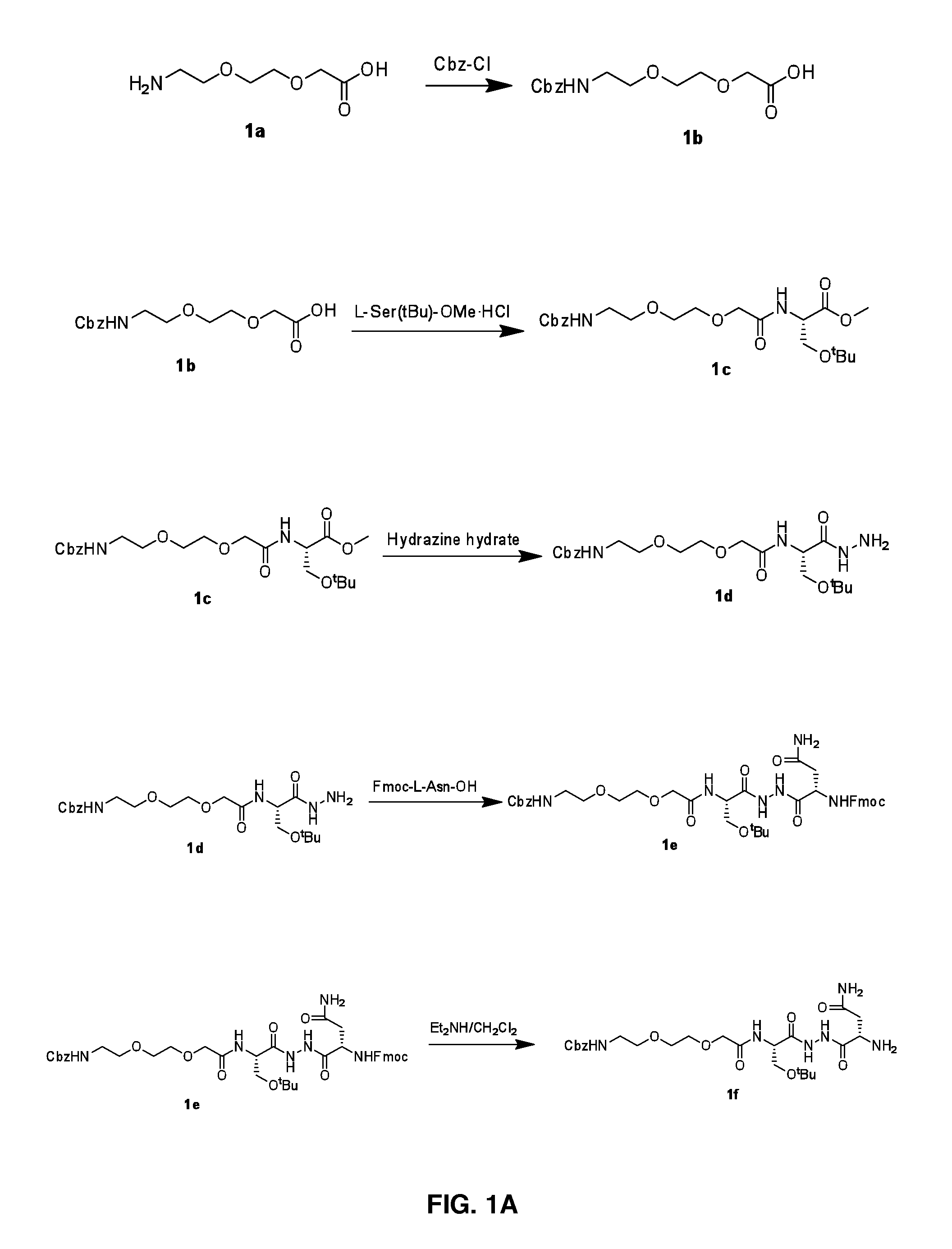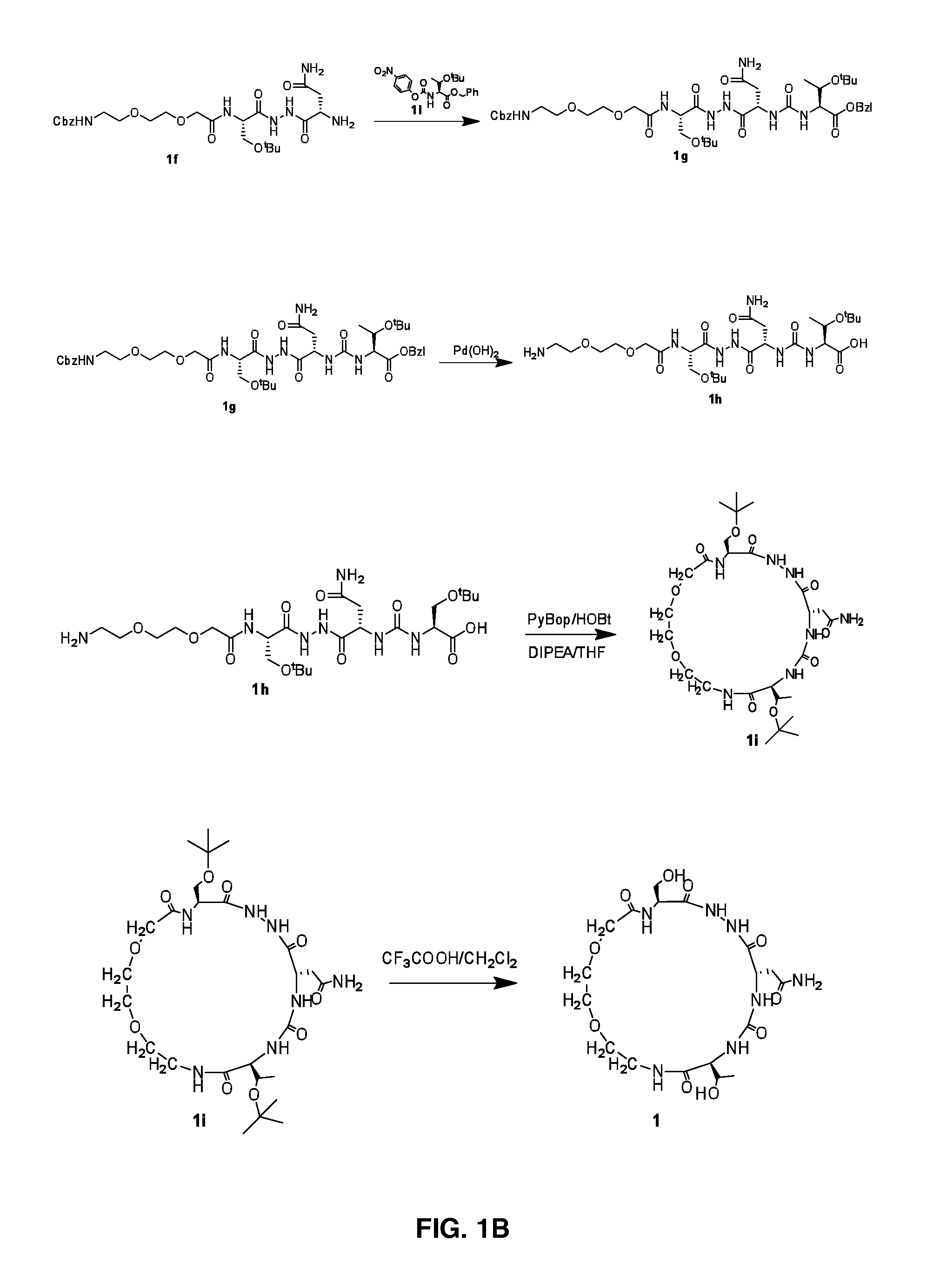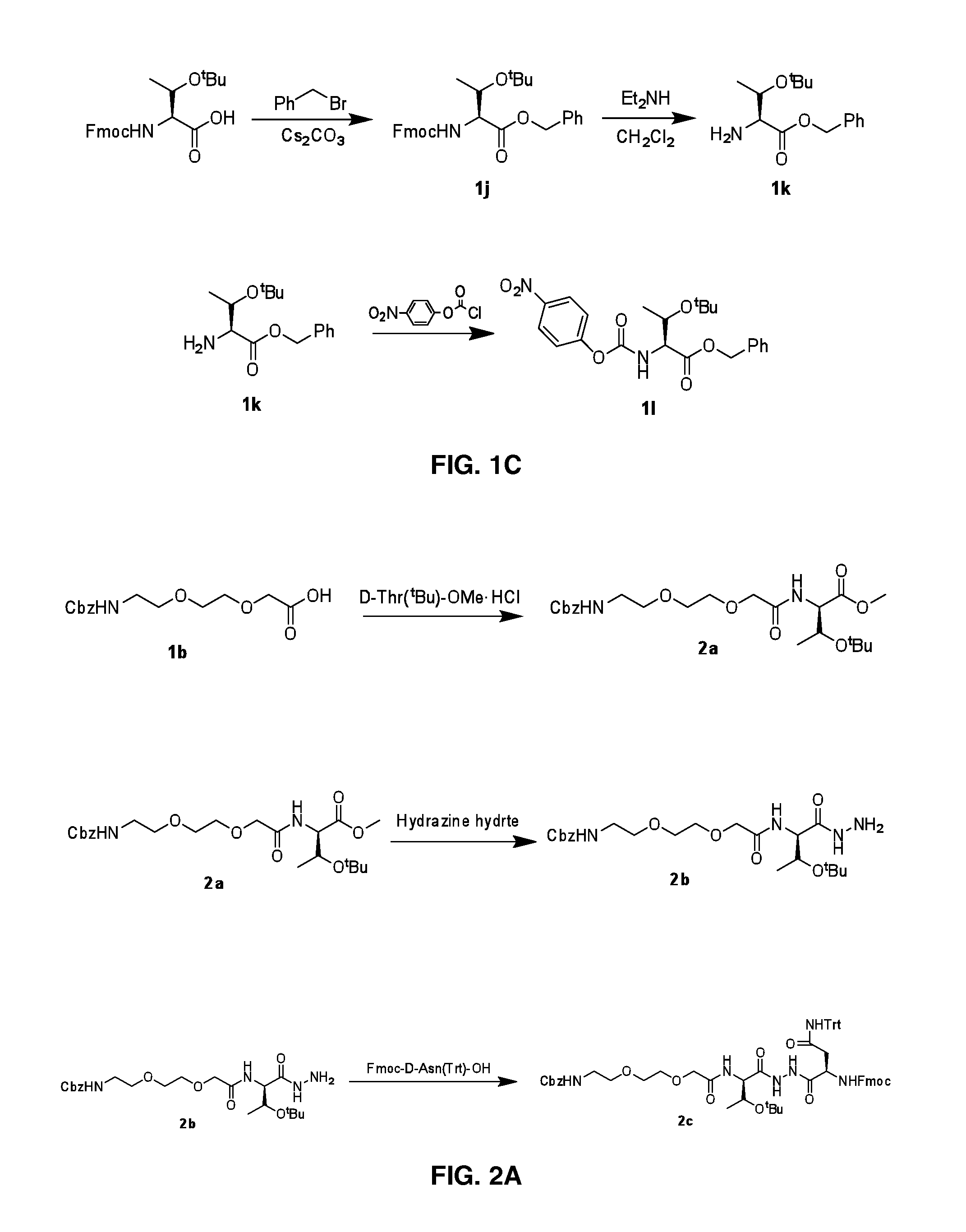Cyclic Peptidomimetic Compounds as Immunomodulators
a technology of cyclic peptides and peptides, applied in the field of cyclic peptides, can solve the problems of immune tolerance breakdown and pathogenic autoimmunity
- Summary
- Abstract
- Description
- Claims
- Application Information
AI Technical Summary
Benefits of technology
Problems solved by technology
Method used
Image
Examples
example 1
Synthesis of Compound 1
[0129]FIGS. 1A-1C illustrate Steps 1a to 1c.
[0130]Step 1a: Sodium hydroxide (12.2 g, 305 mmol) and Cbz-Cl (12.5 g, 73 mmol) were added to a solution of compound 1a (10.0 g, 61 mmol) in water (100 mL) and stirred at room temperature for 3 h. The completeness of the reaction was confirmed by TLC analysis. The reaction mass was partitioned between citric acid solution and ethyl acetate. Organic layer was washed with water, brine, dried over Na2SO4 and evaporated under reduced pressure to yield 11 g of compound 1b (Yield: 61.1%). LCMS: 298.0 (M+H)+.
[0131]Step 1b: DIPEA (3.5 g, 26.8 mmol) was added slowly to a stirred solution of compound 1b (4.0 g, 13.4 mmol) and HATU (5.6 g, 14.7 mmol) in DMF (50 mL) and was allowed to stir at room temperature for 5 more min. To the above reaction mixture L-Ser(tBu)-OMe.HCl (3.5 g, 20.1 mmol) was added slowly and stirred at room temperature for 12 h. The completeness of the reaction was confirmed by TLC analysis. The reaction mix...
example 2
Synthesis of Compound 2
[0140]FIGS. 2A-2B illustrates Steps 2a and 2h.
[0141]Step 2a: DIPEA (2.71 g, 21 mmol) was added slowly to a stirred solution of compound 1b (3.12 g, 10.5 mmol), HATU (4.41 g, 11.6 mmol) in DMF (30 mL) and was allowed to stir at room temperature for 5 min. To the above reaction mixture D-Thr(tBu)-OMe.HCl (2.0 g, 10.5 mmol) was added slowly and stirred at room temperature for 12 h. The completeness of the reaction was confirmed by TLC analysis. The reaction mixture was then quenched with ice, precipitate was filtered and re-crystallized with CH2Cl2 to yield 4.2 g of compound 2a. LCMS: 491.2 (M+Na)+.
[0142]Step 2b: 99% Hydrazine hydrate solution (5 mL) was added slowly to a stirred solution of compound 2a (4.2 g) in methanol (40 mL) and the completion of the reaction was confirmed by TLC analysis. The reaction mixture on evaporation under reduced pressure yielded 4.2 g of compound 2b (Yield: 90%). LCMS: 469.4 (M+H)+.
[0143]Step 2c: DIPEA (2.7 mL, 20.9 mmol) was adde...
example 3
Synthesis of Compound 3
[0150]FIGS. 3A-3C illustrates Steps 3a and 3k.
[0151]Step 3a: To a stirred solution of compound 1a (5.0 g, 30.6 mmol) in 1,4-Dioxane (50 mL), Sodium carbonate (8.12 g, 76.5 mmol, dissolved in 10 mL water) and (Boc)2O (9.98 mL, 45.7 mmol) were added and stirred at room temperature for 12 h. The progress of reaction was monitored by TLC. The reaction mass was partitioned between diethyl ether and water. Then aqueous layer was made acidic (pH=3) by 3N HCl solution and was extracted with DCM (2×200 mL). Organic layer was washed with water, brine, dried over Na2SO4 and evaporated under reduced pressure to yield 50 g of pure 3a (Yield: 62.1%). LCMS: 263.0 (M+H)+.
[0152]Step 3b: DIPEA (6.5 mL, 37.8 mmol) was added slowly to a stirred solution of compound 3b (5 g, 12.6 mmol), compound 3c (2.72 g, 15 mmol), HOBt (2.55 g, 18.9 mmol) and EDC.HCl (3.62 g, 18.9 mmol) in DMF (75 mL) at 0° C. The reaction mixture was further stirred at room temperature for 12 h. The progress o...
PUM
| Property | Measurement | Unit |
|---|---|---|
| Fraction | aaaaa | aaaaa |
| Composition | aaaaa | aaaaa |
| Immunogenicity | aaaaa | aaaaa |
Abstract
Description
Claims
Application Information
 Login to View More
Login to View More - R&D
- Intellectual Property
- Life Sciences
- Materials
- Tech Scout
- Unparalleled Data Quality
- Higher Quality Content
- 60% Fewer Hallucinations
Browse by: Latest US Patents, China's latest patents, Technical Efficacy Thesaurus, Application Domain, Technology Topic, Popular Technical Reports.
© 2025 PatSnap. All rights reserved.Legal|Privacy policy|Modern Slavery Act Transparency Statement|Sitemap|About US| Contact US: help@patsnap.com



